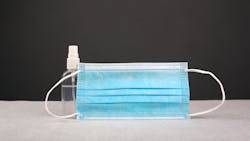Infection control: Going beyond the basics
Infection control—we can do it in our sleep, right? It’s been instilled in us from before we even saw our first dental hygiene patient. But in the time of COVID-19, is infection control in dentistry so black and white and automatic, or is there more to it than simply doing it on autopilot?
As I was doing research for this article, I found myself asking questions like what defines infection control, whether there’s a definitive set of rules for infection control that must be followed, and whether there are guidelines that allow dental professionals to pick and choose which ones which are necessary.
Back to the basics
The Centers for Disease Control and Prevention (CDC) define infection control (IC) as preventing or stopping the spread of infections in health-care settings.1 The CDC has identified two distinct categories of IC: standard precautions and transmission-based precautions.2 Standard IC precautions include universal precautions; when transmission-based precautions are required, they’re used in conjunction with standard precautions, and at times multiple transmission-based precautions may be needed. Examples of transmission-based precautions in dental settings include:
- Contact precautions: These precautions are implemented when a patient has been diagnosed or suspected of having an infection that is spread through contact. This includes using single-use disposable equipment and disinfection practices.
- Droplet precautions: Additional precautions are needed when a patient has been diagnosed with or is suspected of having an infection that is spread through droplets via coughing, sneezing, or even speaking. In dentistry this would include mask-wearing by dental health-care personnel and patients to minimize transmission droplets.
- Airborne precautions: Any infection suspected or diagnosed that can be spread through the air requires additional precautions. In a dental setting, these patients should be placed in an isolation room.3
In medical settings, it may be easier to discern which level of IC to use, but oral health-care providers generally work under the assumption that we’re seeing “healthy” patients. But while dental offices are not typically seeing known sick patients, there’s still the risk that we could encounter patients with a communicable disease such as HIV, influenza, strep throat, or something as benign as a common cold. This risk was highlighted during the early weeks of the COVID-19 pandemic in March 2020.
Early pandemic response
At the start of the pandemic, many dental offices shuttered their doors due to directives from states in an effort to preserve desperately needed personal protective equipment (PPE) for hospital staff and frontline workers, as well as recommendations from local and national dental organizations. Either way, this new, highly contagious airborne virus rocked the dental world. In the weeks and months that followed, the CDC, American Dental Association (ADA), and the American Dental Hygienists’ Association (ADHA), among other dental organizations, created interim guidance for dental offices to minimize the risk of transmission and contraction for both staff and patients. The CDC has recommended that dental health-care professionals adhere to both standard and transmission-based IC procedures during the COVID-19 pandemic.1
Dentistry is an industry in which many procedures create aerosols. This is due to the equipment needed to provide adequate preventive and restorative oral health care. Some of the dental equipment that can produce aerosols are high and slow handpieces, ultrasonic scalers, air/water syringes (when used in combination), air polishing units, and dental lasers. It’s because of aerosol-producing equipment and our close proximity to patients’ oral cavities that dental health-care professionals should implement both standard and transmission-based IC procedures.
The obvious
Between November 2019 and March 2020, 770 dental hygienists participated in an infection control survey; the survey results published in RDH magazine in April 2020, indicated that “47% of dental hygienists wish that infection control procedures in their office would improve.”4 This survey was completed right around the time that COVID-19 was declared a pandemic; either way, at the time of publication, just under half of participating dental hygienists felt that IC in their offices needed improvement.
However, not long after the survey was completed, the Journal of the American Dental Association published a survey that was conducted in June 2020. It indicated that out of 2,195 participating US dentists, 99.7% of dental offices both in the private and public sector had implemented enhanced IC protocols and were providing advanced PPE.5 Infection control is an enormous responsibility for dental health-care workers, with both personal and professional repercussions in cases of negligence. Ensuring that patients can see infection control measures being implemented is vital to making them feel comfortable and safe when receiving dental treatment.
There are levels of IC, such as PPE, that are clearly visible to patients and that the general population has become very familiar with as a result of COVID-19. Patients may be greeted by dental personnel in gowns, N95 masks, face shields, and surgical scrub caps. Another obvious change is in reception areas, with visual social distancing and mask reminders, limited seating, and protective barriers placed between the front desk staff and incoming patients. These changes are a constant reminder that we are living with COVID-19; this is true whether at the dental office or at the grocery store.
As well, many precautionary measures have been implemented to screen patients and staff before they enter the dental facility. These screenings are to minimize exposure either before or immediately when entering the dental office. However, we do this assuming that patients are up-front about their travel, exposure status, or any illness symptoms. The other key factor is for patients or staff who test positive for COVID-19 to communicate their status to anyone else who may have been exposed. Accurate self-reporting and contact tracing is essential.
The not-so-obvious
Dental offices are not often equipped with isolated negative pressure rooms that limit health-care professionals’ exposure to dental aerosols. But if this isn’t a realistic option in dental offices, what can they do to eliminate aerosols? Solutions outlined by the CDC include dental offices increasing the air ventilation capabilities with either portable air filters/purifiers and/or to increase the filtration ability of their HVAC system.1
According to United States Environmental Protection Agency (EPA), air cleaners and HVAC filters can work to decrease the potential for airborne transmission of COVID-19, but this intervention is most effective when used in conjunction with other best practices as outlined by the CDC; any of these as a stand-alone measure won’t offer adequate protection from contracting viruses such as COVID-19.6
HEPA filters are most effective at filtering out COVID-19 when the HVAC system is used continuously, even if only the system fan is running. Due to the ultrafine particle size of the COVID-19 virus, it’s likely that small amounts of it can still pass through a HEPA filter, but when used continuously, these filters can trap and collect a larger amount.7 Small room HEPA filters can also be used in each operatory; the theory is that these additional air purifiers will also help collect aerosolized virus, especially in areas where a window can’t be opened. Approximately 85% of dental practices in the United States are utilizing HEPA air purifiers.5 If the dental operatory has windows, opening them allows fresh air to circulate throughout the office. The CDC also recommends when possible to position the patient’s head closer to a return air vent to direct filtered air toward the patient, which minimizes their potential to exposure to contaminated air.1
High-volume evacuation systems
In response to interim guidelines, some dental offices have equipped dental hygiene operatories with external high-volume evacuation (HVE) suction systems. The Journal of the American Dental Association reported that of the 2,195 US dentists, about 4% indicated that they were using external HVE systems.5 The diameter of the HVE can reduce bioaerosols by approximately 90%; in comparison, the smaller diameter of the saliva ejector is insufficient at reducing aerosolization.8
Currently there are a wide variety of products on the market that range from external and internal HVE. While studies have shown that respiratory droplets can travel about six feet, aerosolized droplet particles can travel approximately 20 feet. The less well-known factor is the amount of time aerosolized droplet nuclei can remain suspended in the air. A study of ultrasonic instruments found that “ultrasonic instrumentation can transmit 100,000 microbes per cubic foot with aerosolization of up to six feet, and, if improper air current is present, microbes can last anywhere from 35 minutes to 17 hours.”9-11 The use of external HVE devices is relatively new in the dental industry, but a preliminary study published in the British Dental Journal demonstrated that in relation to the transmission of COVID-19, “it may be possible to effectively reduce and mitigate the associated risk with the use of external HVE devices.” In conclusion, researchers did state that further studies should include various brands of HVE and should be done in a clinical setting, versus in vitro.11
Infection control is very complex and has many subtopics; this article is just the tip of the iceberg. I believe that the novel coronavirus will change the way dental offices practice IC. Dental professionals must have flexible thinking and adjust IC practices as research and guidelines provide better insight on effective best practices. As we continue to navigate working in a world with COVID-19, we’ll need continued research to identify the effectiveness of current IC measures and ways to improve the standard of practice. The current climate has highlighted areas of strengths and risks of working in the dental field; it’s vital that we’re doing all we can to protect ourselves, our patients, and our community.
References
- Guidance for Dental Settings: Interim Infection Prevention and Control Guidance for Dental Settings During the Coronavirus Disease 2019 (COVID-19) Pandemic. Centers for Disease Control and Prevention. https://www.cdc.gov/coronavirus/2019-ncov/hcp/dental-settings.html
- Wisconsin Department of Health Services. Infection Control and Prevention – Transmission-based precautions. Madison, WI: Wisconsin Dept of Health Services; 2020.
- Habboush Y, Yarrarapu SNS, Guzman N. Infection control. StatPearls. Updated January 5, 2021. https://www.statpearls.com/ArticleLibrary/viewarticle/23480
- Strange M. And the survey says…we gotta step up our infection control game! RDH. April 23, 2020. Accessed December 21, 2020. https://www.rdhmag.com/infection-control/article/14174660/and-the-survey-says-we-gotta-step-up-our-infection-control-game
- Estrich CG, Mikkelsen M, Morrissey R, et al. Estimating COVID-19 prevalence and infection control practices among US dentists. J Am Dent Assoc. 2020;151(11):815-824. doi:10.1016/j.adaj.2020.09.005
- Air cleaners, HVAC filters, and coronavirus. US Environmental Protection Agency. https://www.epa.gov/coronavirus/air-cleaners-hvac-filters-and-coronavirus-covid-19
- Demarco C. Can air purifiers protect you from COVID-19? The University of Texas MD Anderson Cancer Center. September 30, 2020. Accessed December 15, 2020. https://www.mdanderson.org/cancerwise/can-air-purifiers-protect-you-from-coronavirus-covid-19.h00-159385101.html
- Baumann K, Boyce M, Catapano-Martinez D. Transmission precautions for dental aerosols. Decis Dent. December 12, 2018. Accessed December 12, 2020. https://decisionsindentistry.com/article/transmission-precautions-for-dental-aerosols
- Froum S, Strange M. COVID-19 and the problem with dental aerosols. Perio-Implant Advisory. April 7, 2020. Accessed December 12, 2020. https://www.perioimplantadvisory.com/periodontics/oral-medicine-anesthetics-and-oral-systemic-connection/article/14173521/covid19-and-the-problem-with-dental-aerosols
- Miller RL. Characteristics of blood-containing aerosols generated by common power dental instruments. Am Ind Hyg Assoc J. 1995;56(7):670-676. doi:10.1080/15428119591016683
- Nulty A, Lefkaditis C, Zachrisson P, Van Tonder Q, Yar R. A clinical study measuring dental aerosols with and without a high-volume extraction device. Br Dent J. 2020;20:1–8. doi:10.1038/s41415-020-2274-3
MELISSA VAN WITZENBURG, MS, RDH, has been practicing dental hygiene for 17 years. She continues to pursue her passion by helping create an oral health initiative to educate the aging population about oral health and systemic links. Melissa also works clinically in a periodontal office in the Chicagoland area. For more information, please email her at [email protected].
About the Author
Melissa Van Witzenburg, MS, RDH
Melissa has been practicing dental hygiene for 23 years. She continues to pursue her passion by educating the aging population about oral health and systemic links. Melissa also works clinically in a periodontal office in the Chicagoland area. For more information, email her at [email protected].

